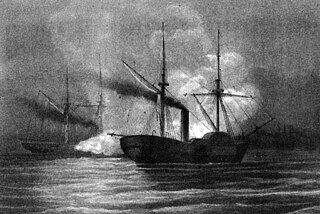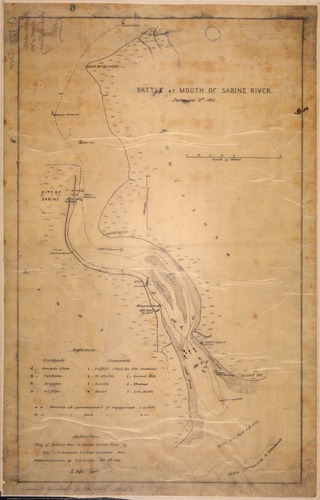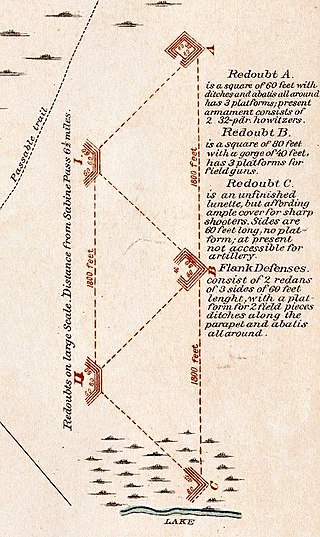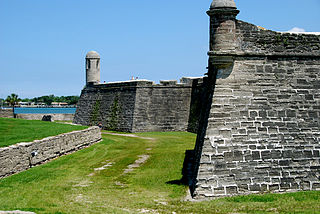
The Confederate States of America (CSA), commonly referred to as the Confederate States or the Confederacy, was an unrecognized breakaway herrenvolk republic in the Southern United States that existed from February 8, 1861, to May 9, 1865. The Confederacy comprised U.S. states that declared secession and warred against the United States during the American Civil War: South Carolina, Mississippi, Florida, Alabama, Georgia, Louisiana, Texas, Virginia, Arkansas, Tennessee, and North Carolina.

The Confederate States Navy (CSN) was the naval branch of the Confederate States Armed Forces, established by an act of the Confederate States Congress on February 21, 1861. It was responsible for Confederate naval operations during the American Civil War against the United States's Union Navy.

The very first USS Hatteras was a 1,126-ton iron-hulled steamer purchased by the Union Navy at the beginning of the American Civil War. She was outfitted as a gunboat and assigned to the Union blockade of the ports and waterways of the Confederate States of America. During an engagement with the disguised Confederate commerce raider, CSS Alabama, she was taken by surprise and was sunk off the coast of Galveston, Texas. The wreck site is one of the few listed on the National Register of Historic Places because of its location away from destructive surf and because of the ship's side-wheel design, which marks the transition between wooden sailing ships and steam-powered ships.

The Second Battle of Sabine Pass was a failed Union Army attempt to invade the Confederate state of Texas during the American Civil War. The Union Navy supported the effort and lost three gunboats during the battle, two captured and one destroyed.
Edward Lea, was an officer in the United States Navy during the American Civil War. He was mortally wounded at the Battle of Galveston and died in the arms of his father, who was on the opposing side in the conflict.

Harriet Lane was a revenue cutter of the United States Revenue Cutter Service and, on the outbreak of the American Civil War, a ship of the United States Navy and later Confederate States Navy. The craft was named after the niece of senator and later United States President, James Buchanan; during his presidency, she acted as First Lady. The cutter was christened and entered the water for the Revenue Service in 1859 out of New York City, and saw action during the Civil War at Fort Sumter, New Orleans, Galveston, Texas, and Virginia Point. The Confederates captured her in 1863, whereupon she was converted to mercantile service. Union forces recaptured her at the end of war. The U.S. Navy declared her unfit for service and sold her. New owners out of Philadelphia renamed her Elliot Ritchie. Her crew abandoned her at sea in 1881.

The Battle of Galveston was a naval and land battle of the American Civil War, when Confederate forces under Major Gen. John B. Magruder expelled occupying Union troops from the city of Galveston, Texas on January 1, 1863.

Texas declared its secession from the Union on February 1, 1861, and joined the Confederate States on March 2, 1861, after it had replaced its governor, Sam Houston, who had refused to take an oath of allegiance to the Confederacy. As with those of other states, the Declaration of Secession was not recognized by the US government at Washington, DC. Some Texan military units fought in the Civil War east of the Mississippi River, but Texas was more useful for supplying soldiers and horses for the Confederate Army. Texas' supply role lasted until mid-1863, when Union gunboats started to control the Mississippi River, which prevented large transfers of men, horses, or cattle. Some cotton was sold in Mexico, but most of the crop became useless because of the Union's naval blockade of Galveston, Houston, and other ports.

Arthur Pendleton Bagby Jr. was an American lawyer, editor, and Confederate States Army colonel during the American Civil War. Confederate General E. Kirby Smith, commander of the Trans-Mississippi Department assigned Bagby to duty as a brigadier general on April 13, 1864, to date from March 17, 1864, and as a major general on May 16, 1865. These extra-legal appointments were not made official by appointments of Bagby to general officer grade by Confederate President Jefferson Davis or by confirmation by the Confederate Senate.

The Battle of Galveston Harbor was fought at Galveston, Texas on October 4, 1862, during the American Civil War. After attempts to blockade the Texas coastline were unsuccessful, the Union Navy decided to attempt to capture the port of Galveston. While Galveston was defended by Confederate forces, most of the cannons in the city's defenses were removed, as Galveston was thought to be indefensible. On October 4, five Union naval vessels commanded by Commander William B. Renshaw approached Galveston, and a single ship, USRC Harriet Lane was sent into Galveston Bay under a flag of truce.

Fort Manhassett was a group of earthen fortifications that guarded the western approaches to Sabine City, Texas during the American Civil War, operating in service of the Confederate Army from October 1863 to May 1865.
The Confederate privateers were privately owned ships that were authorized by the government of the Confederate States of America to attack the shipping of the United States. Although the appeal was to profit by capturing merchant vessels and seizing their cargoes, the government was most interested in diverting the efforts of the Union Navy away from the blockade of Southern ports, and perhaps to encourage European intervention in the conflict.

During most of the American Civil War the Florida city of St. Augustine was under Union control. Its Confederate history was exceedingly brief. One Union general and one Confederate general were natives of the Ancient City. Many officers on both sides had previous military experience in St. Augustine, particularly during the Second Seminole War. The city's historic Sea Wall was built in the 1830s, 1840s and 1850s by West Point engineers who went on to design military fortifications for both sides in the Civil War. Many black Union soldiers either came from St. Augustine, or settled there after the war, providing a leadership cadre for the community known as Lincolnville that was established in 1866. Many of the city's old cemeteries feature the distinctive marble tombstones marked "USCT" – United States Colored Troops.

John Creed Moore was a United States Army officer and a graduate of West Point. He is known for being a Confederate brigadier general during the Civil War and his works in the Texas educational system.

The conclusion of the American Civil War commenced with the articles of surrender agreement of the Army of Northern Virginia on April 9, at Appomattox Court House, by General Robert E. Lee and concluded with the surrender of the Shenandoah on November 6, 1865, bringing the hostilities of the American Civil War to a close. Legally, the war did not end until a proclamation by President Andrew Johnson on August 20, 1866, when he declared "that the said insurrection is at an end and that peace, order, tranquillity, and civil authority now exist in and throughout the whole of the United States of America."
Hispanics in the American Civil War fought on both the Union and Confederate sides of the conflict. Not all the Hispanics who fought in the American Civil War were "Hispanic-Americans", in other words citizens of the United States. Many of them were Spanish subjects or nationals from countries in the Caribbean, Central and South America. Some were born in a US Territory and therefore did not have the right to US Citizenship. It is estimated that approximately 3,500 Hispanics, mostly Mexican-Americans, Puerto Ricans and Cubans living in the United States joined the war: 2,500 for the Confederacy and 1,000 for the Union. This number increased to 10,000 by the end of the war.

The action off Galveston Light was a short naval battle fought during the American Civil War in January 1863. Confederate raider CSS Alabama encountered and sank the United States Navy steamer USS Hatteras off Galveston Lighthouse in Texas.

Throughout the American Civil War, blockade runners were seagoing steam ships that were used to get through the Union blockade that extended some 3,500 miles (5,600 km) along the Atlantic and Gulf of Mexico coastlines and the lower Mississippi River. The Confederate states were largely without industrial capability and could not provide the quantity of arms and other supplies needed to fight against the industrial north. To meet this need blockade runners were built in Scotland and England and were used to import the guns, ordnance and other supplies that the Confederacy desperately needed, in exchange for cotton that the British textile industry needed greatly. To penetrate the blockade, these relatively lightweight shallow draft ships, mostly built in British ship yards and specially designed for speed, but not suited for transporting large quantities of cotton, had to cruise undetected, usually at night, through the Union blockade. The typical blockade runners were privately owned vessels often operating with a letter of marque issued by the Confederate States of America. If spotted, the blockade runners would attempt to outmaneuver or simply outrun any Union ships on blockade patrol, often successfully.
Moses Wright Hannon was a Confederate States Army colonel during the American Civil War. In August 1864, he was assigned to duty as an acting brigadier general by General John Bell Hood, subject to appointment by Confederate President Jefferson Davis and confirmation by the Confederate Senate. Although Hannon commanded a brigade in the cavalry corps of the Army of Tennessee and in Major General Joseph Wheeler's cavalry corps from June 1864 until the end of the war, he never was officially appointed by Jefferson Davis and confirmed by the Confederate Senate to brigadier general rank.

Leonidas R. Smith was an American steamboat captain and soldier. In the American Civil War he served the Confederate States of America as a volunteer; he was named Commander of the Texas Marine Department under General John B. Magruder. Smith was involved in most major conflicts along the Texas coast during the war, and was described by war-time governor of Texas Francis Lubbock as "undoubtedly the ablest Confederate naval commander in the Gulf waters".















